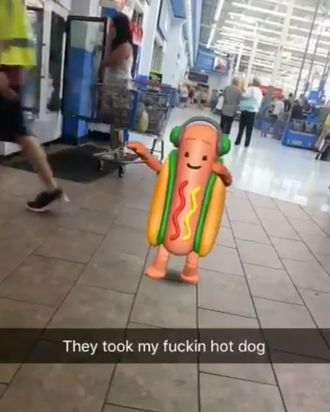
I’d like to take you back in time to the summer of 2017. The headlines at the time were dire: Donald Trump and Vladimir Putin shook hands at the G20 summit. The US Court of Appeals for the Ninth Circuit heard a case on whether or not a selfie-taking monkey could own the copyright to said selfie. The World Health Organization announced that gonorrhea was becoming harder, if not impossible, to treat. And yet there was a single bright spot — a promise, amidst the darkness, of a better future: Snapchat released a lens that let you place a dancing hot dog into your photos and videos.
The hot dog wasn’t Snapchat’s first augmented reality lens. It wasn’t even, arguably, its best augmented reality lens. (I’m partial to the bread-face lens also released in early summer 2017.) Unlike the elaborate fantasias promised by augmented-reality companies like Magic Leap, the hotdog gimmick was simple: Users could drag and drop a 3-D hot dog wearing headphones onto any surface they could see through the camera lens — a table, an outstretched palm, a sidewalk — and the hot dog would dance. And yet, somehow, it was the dancing hot dog that became an internet-wide phenomenon — the thing that turned augmented reality from a much-hyped promise to a meme-able technology — whether the people using the lenses realized it or not.
Intelligencer caught up with several Snap employees to get the full story on how everyone’s favorite hot dog DJ came into existence.
“One of our challenges was to introduce the Snapchatters to this completely new experience, to use AR in the wild, on the other side of the camera. So not just lenses for your face. The first character dancing was actually the dancing cow,” Lidiya Bogdanovich, who leads lens design at Snap, told Intelligencer. “It was a completely new thing for us, from a technical point of view and from a creative point. We noticed that people loved it, because they had found a new way to interact with AR in the real world. So we started thinking about other characters that people might like, so we thought, what do people like? They like animals, pizza, burgers, french fries, avocados … hot dogs.” From there, Bogdanovich said someone drew up a “quick napkin sketch” of what would become the hot dog lens.
Next came the dance moves. “We brainstormed with the team. It actually looks like a talent show, like a dance challenge,” she explained. “Everybody does moves and we sometimes do recordings and use it as a reference for our animators. They make the finalization of the character in 3-D.” The lens launched on June 23, 2017. Bogdanovich noted that Snap rereleased the lens after it started picking up meme steam. “The second time it was a tremendous hit. It still remains one of our biggest world lens hits.”
The memes were what propelled what might have otherwise been a passing AR ship into a viral moment. “There was a Snap posted to Twitter that captured a grocery cart ‘picking up’ the hot dog character that I believe first kicked off the internet craze,” said Eitan Pilipski, the VP of Snap’s Camera Platform. “From there, we saw memes around ‘how to get the hot dog’s look,’ spin-offs around the ‘real v. fake’ versions of the characters, Snapchatters dancing alongside of it, pretending to be surprised when they saw it pop up in their kitchen.” Said Bogdanovich, “It was even a part of the Teen Choice Awards … there was a hot dog presenting onstage.” Months later, Snapchat would sell an official Dancing Hot Dog Halloween costume for $80. Which people actually purchased and wore.
The love for the hot dog is the kind of thing companies dream of manufacturing. That Snapchat happened upon it organically was even better for business. “The dancing hot dog, for us, was absolutely a game-changer as we thought about how do we push advertisers to augmented reality. A lot of advertisers themselves aren’t familiar with AR, certainly weren’t at that point.” Jeff Miller, global head of creative strategy, said. “I think [what] the dancing hot dog does so beautifully is within a second, you instantly understand the context, and you instantly have this emotional reaction. You want to smile.”
“Those dancing characters, the hot dog in particular, have been really important for AR in general,” Bogdanovich said. “Before that, AR was for tech people. Now it’s available for everybody … to work into our everyday lives. Now it’s fun.” She’s right, sort of. If you asked the average person to tell you about a famous moment involving AR, they likely couldn’t come up with something. But chances are good they saw the dancing hot dog in the summer of 2017. Even if they didn’t realize they were witnessing AR’s biggest moment to date.





























